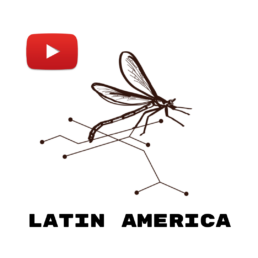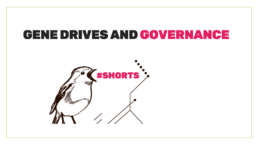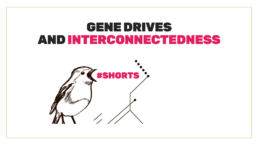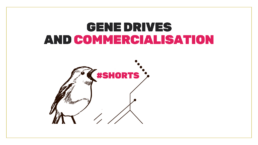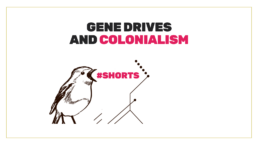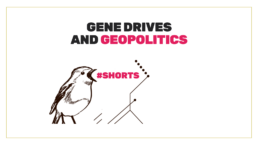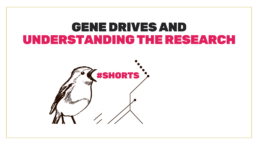Worldwide: Experts on Gene Drives
We are travelling the world speaking to some of the world’s leading thinkers, activists and academics on the impact of gene drives.
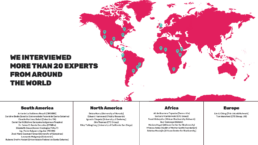
Join us for this video series as we hear from a diverse range of experts on one of the most powerful new emerging technologies that we face.
FULL INTERVIEWS
Gene Drives: exploring the impact on biodiversity and livelihoods
Interview with Jim Thomas, ECT Group Quebec, Canada
Jim explores questions around assumptions of the human ability to ‘engineer’ the biosphere, how the discussion and narrative around synthetic biology has changed politically and focusing on the bigger picture of gene drives versus specific use cases.
Gene Drives: understanding the military and political influence
Interview with Edward Hammond, Prickly Research, Maryland, USA
Gene drives are an extremely new technology with many risks and unanswered questions. Despite this there has been intense military and business interest in the approval process and a push to deploy them as soon as possible.
Gene Drives: extending the patterns of colonisation
Interview with Debra Harry, University of Nevada, USA
Debra Harry explores key questions around the differences in worldview between gene drive developers and indigenous wisdom and the ties between the proposed uses of gene drives and the present and past reality of colonialism.
Gene Drives: analyzing the cultural background
Interview with Ignacio Chapela, University of California Berkeley
Ignacio Chapela explains how, underlying the mentality of biotechnology, is the assumption that the living world can be pushed to behave in the same mechanistic ways as the material, non-living world.
Gene Drives: the missing perspectives
Interview with Riley Taitingfong, University of of California San Diego, USA
Riley Taitingfong explores different perspectives on debates over gene drives, analysing how the researchers and gene drive marketers try to manipulate the public into accepting this technology.
Gene Drives: contextualising technology assessment
Interview with Tom Wakeford, ETC Group, the United Kingdom
Tom Wakeford explains what horizon-scanning is and outlines how the ‘dominant knowledge system’ factor prevails in current debates over gene drives.
Gene Drives: evaluating the role of the United Nations
Interview with Lim Li Ching, Third World Network, the United Kingdom
In this interview, Ching describes how horizon-scanning and monitoring of potentially hazardous new biotechnologies are embedded in the historical origins and central provisions of the work of UN Convention on Biological Diversity – and also apply to gene drives.
Gene Drives: identifying false solutions
Interview with Sabrina Masinjila, the African Center for Biodiversity, Tanzania
Sabrina describes the phenomenon of the corporate capture of some African governments by the biotech industry, emphasizing why it is important to always protect and uphold the rights of smallholder farmers and local communities.
Gene Drives: exploiting the lack of awareness
Interview with Mfoniso Antia, Health of Mother Earth Foundation, Nigeria
Providing a Nigerian perspective on new technologies like gene drives, Mfoniso explains the role of African Technology Assessment Platform in spreading awareness and raising critical questions about new technologies, including gene drives, and the impact.
Gene Drives: learning from African traditional knowledge
Interview with Fassil Gebeyehu, African Biodiversity Network, Ethiopia
Fassil presents the different approach that indigenous perspective brings to understanding technological interventions into the natural world. He also examines how we could strive for maintaining the equilibrium between the scientific and indigenous knowledge systems in the context of gene drives research.
Gene Drives: evaluating gene drive mosquitoes for Uganda
Interview with Barbara Ntambirweki, ETC Group, Uganda
Warning that the prospects of the environmental release of gene drives are extremely alarming, Barbara Ntambirweki uncovers the different layers of risks that environmental releases of gene drives could bring for the environment.
Gene Drives: examining the biosafety aspect
Interview with Caroline Bedin Zanatta, UFSC, Brasil
Caroline describes a range of biosafety technical tools and scientific methods available to do effective unbiased biosafety science, pointing out that biosafety research is often left neglected as many researchers have commercial interests invested in the companies developing GMO products.
Gene Drives: understanding the effects of CRISPR/Cas9
Interview with Prof. Dr. Rubens Onofre Nodari, UFSC, Brasil
In the interview Prof. Nodari discusses the current state of science regarding what is known of the effects of CRISPR/Cas9 genome editing, as well as the implications of using CRISPR/Cas9 in gene drive systems, and how evolutionary biology would impact on any release of gene drive organisms.
QUESTIONS & ANSWERS
Ali Tapsoba & Guy Yaméogo
Q3. What were the concerns of Burkinabe civil society about GMO cotton?
Q5. Was the cultivation of GMO cotton stopped in Burkina Faso?
Q6. When did the production of GMO cotton cease in Burkina Faso?
Q17. Do you support a moratorium on gene drive organisms releases by the UN Biodiversity Convention?
Barbara Ntambirweki
Q1. Why are you participating in the UN Biodiversity Convention meetings about gene drives?
Q2. Are there any gene drive mosquito projects currently in Uganda?
Q3. Do you have any issues with Target Malaria’s gene drive project in Uganda?
Q4. What concerns do you have about Target Malaria’s gene drive project in Uganda?
Q6. What concerns do you have about the UN Biodiversity Convention discussions over gene drives?
Q10. What would you like to see from African governments in their approach to gene drives?
Fassil Gbeyehu
Q4. Do gene drives pose different risks for African countries than they do for Western countries?
Q7. Do you think new biotechnologies like gene drives are a threat to Africa’s biodiversity?
Q10. How can we create more space for traditional knowledge in debates over gene drives?
Mariam Mayet
Q5. Solutions and Products for Fighting Malaria & the Target Malaria Gene Drives Project
Q6. What kind of investments are driving Target Malaria’s gene drives project?
Q7. What has been the influence of the Gates Foundation on approaches to malaria control in Africa?
Mfoniso Anti
Q1. What is AfriTAP (African Technology Assessment Platform) and how does it relate to gene drives?
Q2. What kinds of technologies has AfriTAP been working on besides gene drives?
Q5. What concerns do you have about gene drive technologies?
Q6. AfriTAP’s Webinars on Technology Assessment Issues in Africa
Q7. Are there any gene drive projects in Nigeria?
Q9. What essential questions need to be asked in a technology assessment of gene drives?
Q10. What would you say to Target Malaria at Imperial College London?
Sabrina Masinjila
Q1. Concerns about gene drives in the Post-2020 Global Biodiversity Framework
Q4. Why are today’s African governments seemingly more favourable toward gene drives?
Lim Li Ching
Q5. Do gene drive organisms need new forms of risk assessment than earlier GMOs?
Q6. Who would be liable for any damage caused by gene drive organisms?
Tom Wakeford
Q1. Why is technology assessment of new technologies like gene drives important?
Q3. What kinds of people might be involved in technology assessment of gene drives?
Q4. Why should technology assessment of gene drives not only be left to scientists?
Q5. What kinds of knowledge would need to be considered in a technology assessment of gene drives?
Q6. How does the ‘dominant knowledge system’ factor in current debates over gene drives?
Q12. How can technology assessment of new technologies like gene drives be more inclusive?
Q13. How is technology assessment carried out by the UN Biodiversity Convention?
Q14. Why is the voice of civil society important in technology assessment of gene drives?
Q15. What is the ‘assess.technology’ website that ETC Group and partners have created about?
Q16. What is meant by the term ‘horizon-scanning’ in debates over new technologies like gene drives?
Antonietta Gutièrrez Rosati
Q1. How has the awareness of biosafety developed historically in Peru?
Q2. What were the beginnings of Peru’s institutional approach to biosafety?
Q3. When did Peru create its first biosafety law?
Q4. What difficulties has Peru faced in implementing national biosafety laws?
Q6. How was Peru’s national moratorium on introducing GMOs achieved?
Q7. What were the objectives of Peru’s GMO moratorium?
Q8. How has Peru’s GMO moratorium influenced biosafety governance?
Q9. Why was Peru’s GMO moratorium recently extended to 2035?
Q10. What have been the most important results of Peru’s GMO moratorium?
Q11. Has Peru’s GMO moratorium influenced Peru’s national identity?
Q12. How has Peru’s food culture been influenced by Peru’s GMO moratorium?
Q14. How does Peru’s GMO moratorium relate to debates over new genetic technologies in Peru?
Q16. Has there been much discussion of new genetic technologies like gene drives in Peru?
Q18. Is Peru developing legislation on gene drives or other new genetic technologies?
Caroline Bedin Zanatta
Q3. Why are you interested in researching biosafety?
Q4.What is the ‘Food Print’ project?
Q5. GM Mosquitos Release in Brazil
Q6. Do we have the ability to monitor and track the release of the newer gene edited organisms?
Q7. What is Brazil’s role in ‘Food Print’?
Q8. Is there much discussion in Brazil about genetic engineering?
Claudio Martinez Debat
Q10. What is ‘the Republic of Soya’?
Daniel Santi
Q3. Are Indigenous Peoples genuinely being heard at international meetings like the UNCBD?
Dr. Elizabeth Bravo
Q1. When was Ecuador’s constitutional prohibition of GMOs achieved?
Q2. How was the article in Ecuador’s constitution prohibiting GMOs introduced?
Q3. Ecuador & Genetic Engineering
Q4. Has there been opposition to Ecuador’s constitutional prohibition of GMOs?
Q5. Gene Drives & Invasive Species in the Galapagos Islands
Q6. Ecuador’s constitutional prohibition on GMOs & Gene Drives in the Galapagos Islands
Q7. New Genetic Technologies & ‘De-extinction’
Q8. How has the system of transgenic agriculture impacted ecology and culture in Latin America?
Q9. How do you view risk assessment of new genetic technologies like gene drives?
Q10. How do you view proposals to use GM or gene drive mosquitoes for public health purposes?
Q11. Would using new genetic technologies to resurrect extinct species help to recover ecosystems?
Q12. Problems Surrounding GMO Agriculture in Latin America
Q13. The IUCN and the proposal to use gene drives for nature conservation
Q14. Rights of Nature in Ecuador and New Genetic Technologies
Dr Jaime García González
Q1. What has been the background of debates around GMOs in Costa Rica?
Q4. What concerns do you have about Costa Rica’s production of GMO seeds for export?
Q6. What concerns do you have with debates around the introduction of new genetic technologies?
Q9. On proposals to use gene drives for nature conservation
Q17. How do you view the involvement of some celebrities in promoting new genetic technologies?
Q18. How do you view public relations surrounding new genetic technologies?
Q21. Do you think scientists have the power to ‘control life’ with new genetic technologies?
José Maria Gusman Ferraz
Q1. What were the circumstances surrounding the release of Oxitec’s GMO mosquitoes in Brazil?
Q2. How were Oxitec’s GM mosquito tests in the Brazilian communities of Jacobina and Juazeiro
Q3. How did you respond to Oxitec’s proposed release of GM mosquitoes in Jacobina and Juazeiro?
Q6. What was the response of CTNBio to your concerns raised about Oxitec’s GM mosquito releases?
Q9. Were there other experimental GM mosquito releases in Brazil?
Q11. Did Oxitec’s GM mosquitoes get approval for commercial release in Brazil?
Q12. What are some of the concerns you have with CTNBio’s approval process for GMOs?
Q14. What other GMO experiments in Brazil did you have concerns about as a CTNBio member?
Q15. What other concerns do you have about gene drive organisms?
Leonardo Melgarejo
Q1. Is Brazil also planning on releasing gene drives?
Q2. Brazil & Concerns on Experimental Releases of GM Mosquitos?
Q3. GM Mosquitos & Mosquito Population Suppression in Brazil
Q4. What concerns do you have about potential gene drive mosquito releases in Brazil?
Q5. Why have GM mosquito releases continued in Brazil?
Q6. Lack of Transparency & Releases of GM Mosquitos in Brazil
Q7. Is Brazilian food insecurity related to the expansion of genetic engineering in Brazil?
Q8. What concerns do you have as a Brazilian about gene drive technology?
Q17. How does Brazil’s approval of many pesticides banned elsewhere relate to gene drives?
Q18. What is an illustrative example of a ‘cisgenic’ product?
Q19. What is your concern with the expansion of new genetic technologies in Brazil?
Q20. What are your concerns with Brazil being a producer of GMO commodity crops for export?
Q25. What other concerns do you have about the expansion of GMO agriculture in Brazil?
Prof. Dr. Rubens Onofre Nodari
Q1. International Collaborative Project on the Unintentional Effects of CRISPR/Cas9 Gene Editing
Q5. How developed is current scientific understanding of the effects of CRISPR/Cas9 gene editing?
Q6. Is CRISPR/Cas9 cheaper and easier to use than previous genetic engineering technologies?
Q9. Does CRISPR/Cas9 give us the power to control evolution?
Q11. What do you think about plans for using gene drives to eliminate invasive species?
Q12. What could potentially go wrong with using gene drives mice to eliminate invasive rodents?
Q13. Gene Drives & Genetic Modifications
Q14. Why are some scientists seemingly so fixated on using gene drives to solve problems?
Q15. What is ‘sound science’ in relation to gene drives?
Q17. Governments & Responsible Approaches to Regulating New Biotechnologies
Dr. Debra Harry
Q1. Is there an indigenous peoples’ perspective on gene drives?
Q2. How do indigenous peoples evaluate biotechnologies like gene drives?
Q3. Should human beings be rewriting the genetic code of life?
Q4. Is controlling or owning the genetic basis of life also a kind of colonialism?
Q5. How do indigenous people’s traditional knowledge systems factor in debates over gene drives?
Q6. How is an indigenous people’s worldview different from that of Western societies?
Q7. How can Western science better engage with indigenous peoples?
Edward Hammond
Q1. CBD & Gene Drives and Conflicts of Interest
Q2. What would a robust assessment of the risks of gene drives look like?
Q5. Who should be consulted in making decisions about the deployment of gene drives?
Q6. Why is an inclusive process necessary in discussions about gene drives?
Q7. How can we insure accountability in decision making around gene drives?
Ignacio Chapela
Q1. Gene Drives & Transgenic Contamination
Q3. Are gene drives’ promises science fiction?
Q4. How has cultural engineering influenced debates over GMOs and now gene drives?
Q6. Indigenous and Local Communities & the right to say ‘no’ to gene drive organisms
Q7. Are gene drives more dangerous than earlier GMOs?
Jim Thomas
Q1. Why does ETC Group campaign on gene drives?
Q2. Why is there such apparent haste from groups to deploy gene drives?
Q3. Are gene drives a radical departure from earlier genetic engineering technologies?
Q4. Why does ETC Group campaign for ‘technology assessment’ of gene drives?
Q5. What are some of the key debates in assessing gene drive technology?
Q6. What kind of conversations should we be having about gene drives?
Riley Taitingfong
Q3. As an indigenous scholar how do you approach debates over gene drives?
Q4. Gene Drive Developers & Local and Indigenous Communities
Q5. What is a ‘deficit model of engagement’?
Q6. How could engagement over gene drives be done differently?
Q7. Are islands really contained places suitable for gene drives experimentation?
Q12. How can we better frame our conversations about gene drives?















